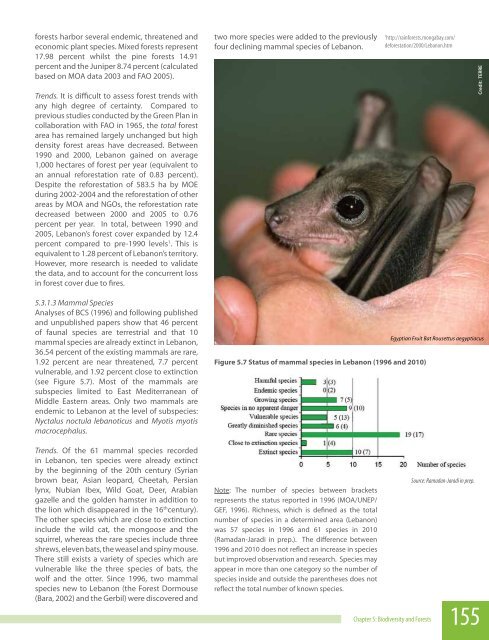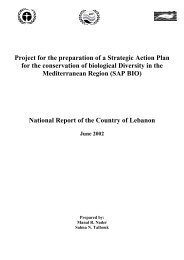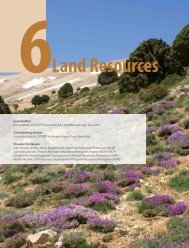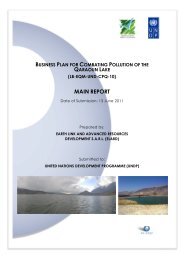Biodiversity and Forests
Biodiversity and Forests
Biodiversity and Forests
Create successful ePaper yourself
Turn your PDF publications into a flip-book with our unique Google optimized e-Paper software.
forests harbor several endemic, threatened <strong>and</strong><br />
economic plant species. Mixed forests represent<br />
17.98 percent whilst the pine forests 14.91<br />
percent <strong>and</strong> the Juniper 8.74 percent (calculated<br />
based on MOA data 2003 <strong>and</strong> FAO 2005).<br />
Trends. It is difficult to assess forest trends with<br />
any high degree of certainty. Compared to<br />
previous studies conducted by the Green Plan in<br />
collaboration with FAO in 1965, the total forest<br />
area has remained largely unchanged but high<br />
density forest areas have decreased. Between<br />
1990 <strong>and</strong> 2000, Lebanon gained on average<br />
1,000 hectares of forest per year (equivalent to<br />
an annual reforestation rate of 0.83 percent).<br />
Despite the reforestation of 583.5 ha by MOE<br />
during 2002-2004 <strong>and</strong> the reforestation of other<br />
areas by MOA <strong>and</strong> NGOs, the reforestation rate<br />
decreased between 2000 <strong>and</strong> 2005 to 0.76<br />
percent per year. In total, between 1990 <strong>and</strong><br />
2005, Lebanon’s forest cover exp<strong>and</strong>ed by 12.4<br />
percent compared to pre-1990 levels 1 . This is<br />
equivalent to 1.28 percent of Lebanon’s territory.<br />
However, more research is needed to validate<br />
the data, <strong>and</strong> to account for the concurrent loss<br />
in forest cover due to fires.<br />
5.3.1.3 Mammal Species<br />
Analyses of BCS (1996) <strong>and</strong> following published<br />
<strong>and</strong> unpublished papers show that 46 percent<br />
of faunal species are terrestrial <strong>and</strong> that 10<br />
mammal species are already extinct in Lebanon,<br />
36.54 percent of the existing mammals are rare,<br />
1.92 percent are near threatened, 7.7 percent<br />
vulnerable, <strong>and</strong> 1.92 percent close to extinction<br />
(see Figure 5.7). Most of the mammals are<br />
subspecies limited to East Mediterranean of<br />
Middle Eastern areas. Only two mammals are<br />
endemic to Lebanon at the level of subspecies:<br />
Nyctalus noctula lebanoticus <strong>and</strong> Myotis myotis<br />
macrocephalus.<br />
Trends. Of the 61 mammal species recorded<br />
in Lebanon, ten species were already extinct<br />
by the beginning of the 20th century (Syrian<br />
brown bear, Asian leopard, Cheetah, Persian<br />
lynx, Nubian Ibex, Wild Goat, Deer, Arabian<br />
gazelle <strong>and</strong> the golden hamster in addition to<br />
the lion which disappeared in the 16 th century).<br />
The other species which are close to extinction<br />
include the wild cat, the mongoose <strong>and</strong> the<br />
squirrel, whereas the rare species include three<br />
shrews, eleven bats, the weasel <strong>and</strong> spiny mouse.<br />
There still exists a variety of species which are<br />
vulnerable like the three species of bats, the<br />
wolf <strong>and</strong> the otter. Since 1996, two mammal<br />
species new to Lebanon (the Forest Dormouse<br />
(Bara, 2002) <strong>and</strong> the Gerbil) were discovered <strong>and</strong><br />
two more species were added to the previously<br />
four declining mammal species of Lebanon.<br />
Figure 5.7 Status of mammal species in Lebanon (1996 <strong>and</strong> 2010)<br />
Note: The number of species between brackets<br />
represents the status reported in 1996 (MOA/UNEP/<br />
GEF, 1996). Richness, which is defined as the total<br />
number of species in a determined area (Lebanon)<br />
was 57 species in 1996 <strong>and</strong> 61 species in 2010<br />
(Ramadan-Jaradi in prep.). The difference between<br />
1996 <strong>and</strong> 2010 does not reflect an increase in species<br />
but improved observation <strong>and</strong> research. Species may<br />
appear in more than one category so the number of<br />
species inside <strong>and</strong> outside the parentheses does not<br />
reflect the total number of known species.<br />
1 http://rainforests.mongabay.com/<br />
deforestation/2000/Lebanon.htm<br />
Source: Ramadan-Jaradi in prep.<br />
Chapter 5: <strong>Biodiversity</strong> <strong>and</strong> <strong>Forests</strong> 155<br />
Credit: TERRE<br />
Egyptian Fruit Bat Rousettus aegyptiacus





